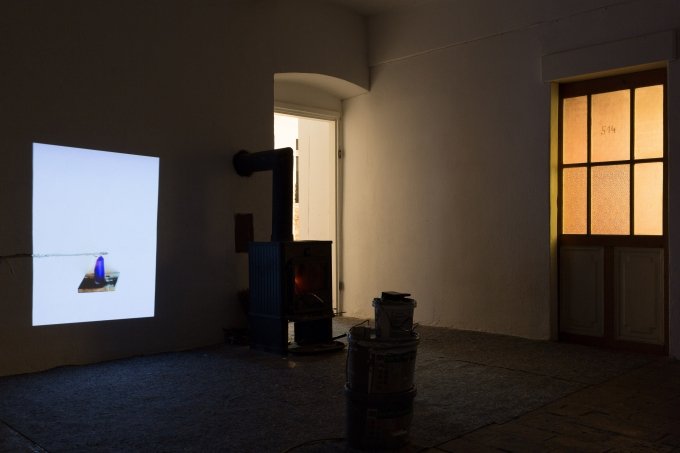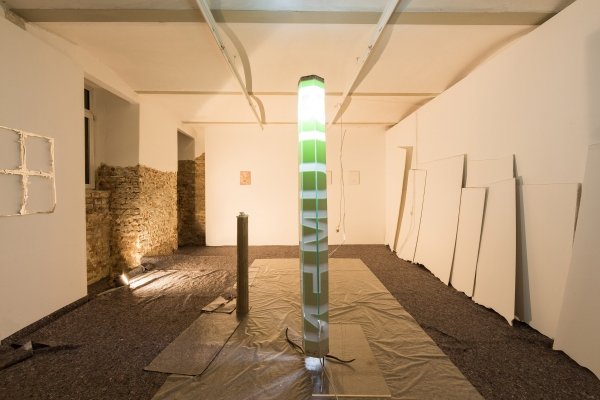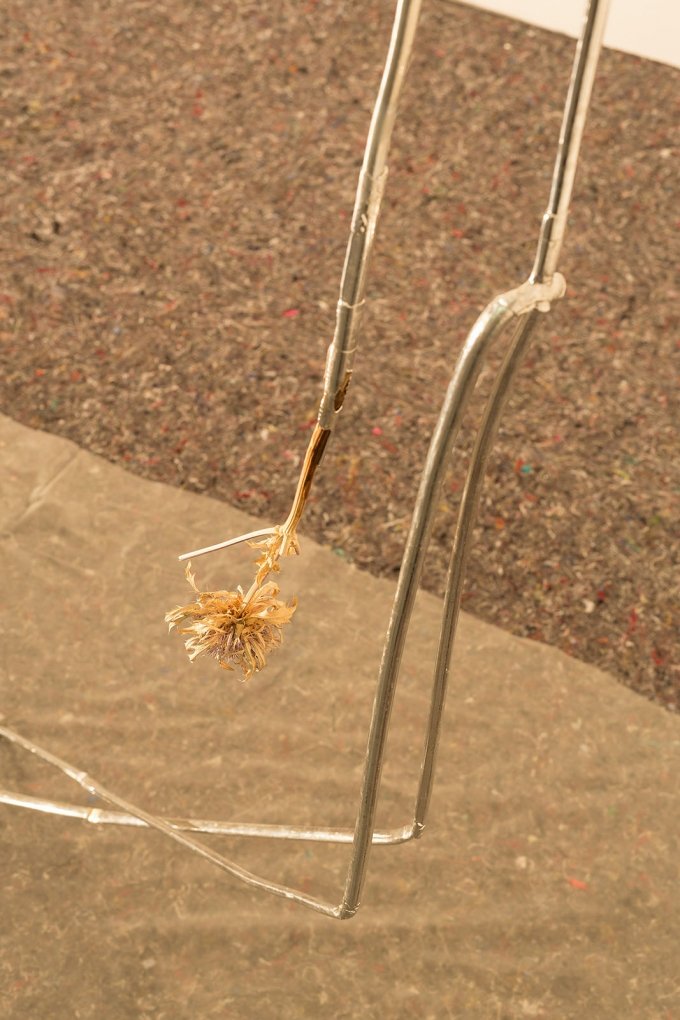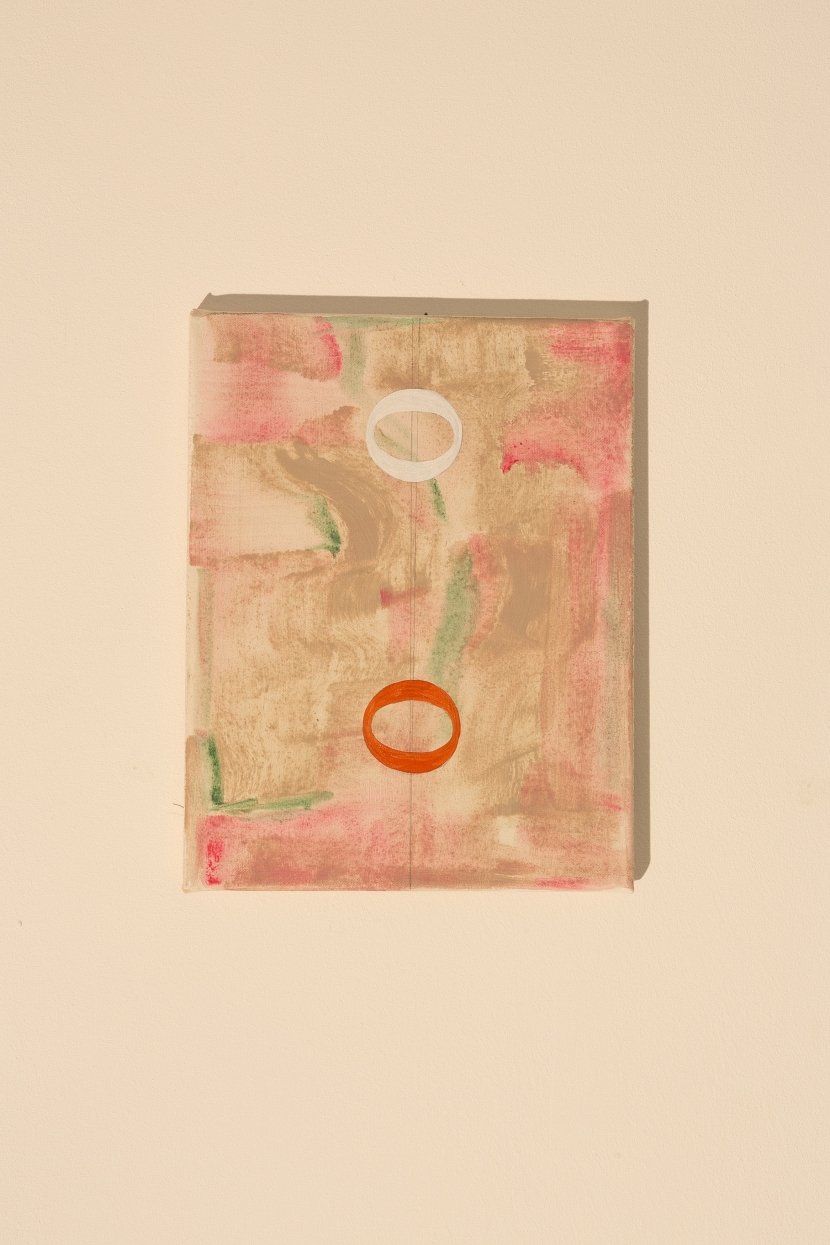Katharina Hölzl & Eugen Wist bei foundation, Wien
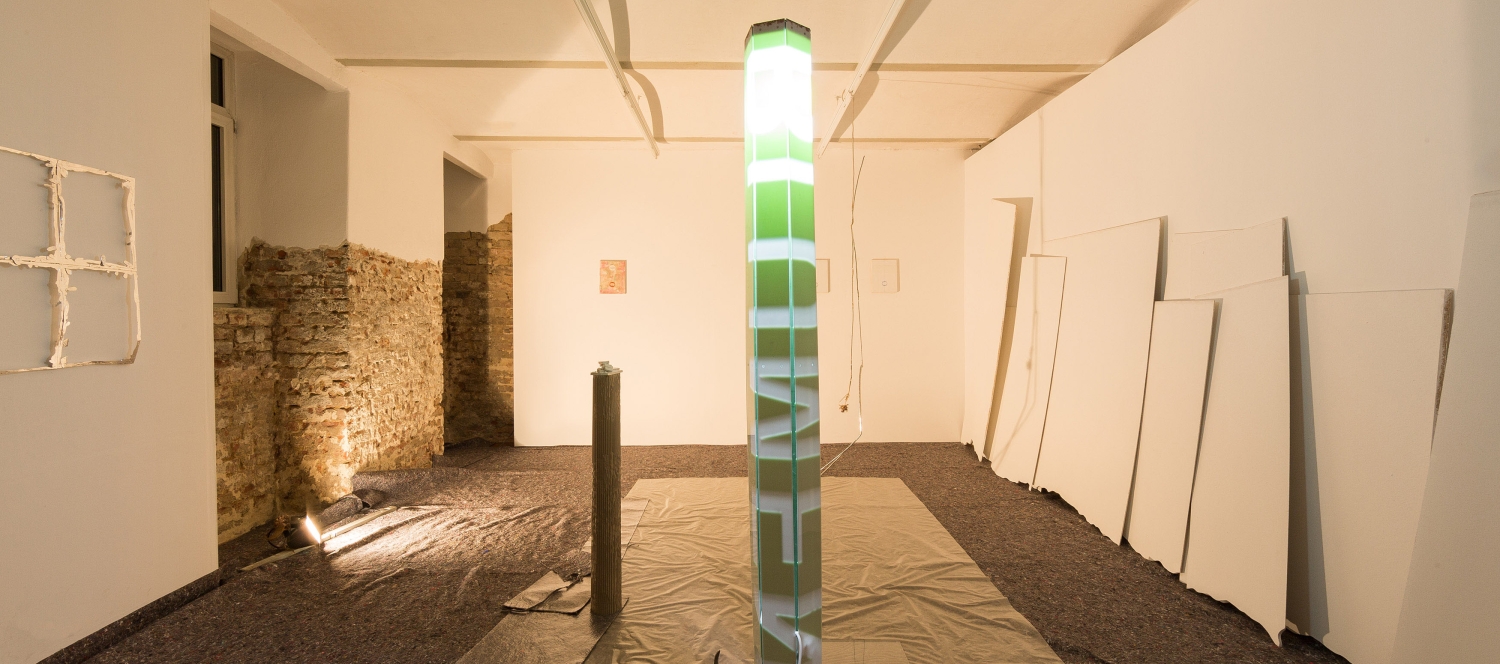
foundation
Hainburgerstraße 47/1, 1030 Wien
Österreich
KünstlerInnen: Katharina Hölzl, Eugen Wist
Titel: nouveau niveau
Datum: 31. Januar bis 2. März 2019
Fotografie: Courtesy die KünstlerInnen und foundation, Wien | Foto: S.H. & foundation
Artist Statement
Part 1: Eugen Wist
Part 2: Katharina Hölzl
When yet another flower store goes out of business, I always imagine it as a large scale vanitas sujet. In about the same time as your bouquet at home slowly loses its gorgeous colors and starts to dry out, the store moves out its flowers and displays, to make place for the new. In a short period absolutely nothing happens – no one goes in or out, the decoration is gone; the stains, the wall cracks, and all the flaws appear even more intense because it was covered by literal beauty. So I look at this four-story house, where a leftover light-sign above the void says: BLUMEN Like the occasional flower, which ends up between the conserving pages of a catalogue, I pick these conceptual flowers from the house wall and put them in a suitable box.
Have you ever been looking at the clock and seen recurring numbers, 00:00, 11:11, 22:22? Intuitively one knows it’s a message. Spirit guides might get your attention when they show you something repeatedly. Per-haps that’s because something is meeting the eyes half-way and numbers are everywhere, hiding and showing at the same time. Other examples include covers on motorcycles, bikes and furniture in winter time, shaping bulbs out of differing silhouettes. Or rooftop architecture seen through the mirror image of muddy puddles. Distractions are lurking around every corner.
Ausstellungstext:
What is the collaborative aspect of the pairing of these two artists? What exactly is accomplished by collaborative undertakings in the arts? In these two directions of thought alone lie a thousand problems. Maybe not problems: more so, angles. Not angels. The knowledge and structural perception of this currently popular format can be dissected if we choose so. It might therefore be important to first rule out if we find ourselves here in some haphazard situation, or if someone has been thoughtful here or at least has some skin in the game. In this sense, I use this text partly for general thought processes. The introduction serves partly to raise questions from my point of view as the author of this text who is also a spectator, and to introduce at the same time a general topic that is meandering around as a format in contemporary art exhibitions and interventions.
Collaborations are mostly linked to alternative spaces, or the so-called “off-spaces” in German. Deriving from a practice that first emerged in the 1960s, in rather isolated occurences, a newer, more widespread version of the collaborative became prominent in the 1990s, with “the artist […] conceived less as an individual producer of discrete objects than as a collaborator and producer of situations; the work of art as a finite, portable, commodifiable product […] reconceived as an ongoing or long-term project with an unclear beginning and end; while the audience, previously conceived as a ‘viewer’ or ‘beholder’, […] now repositioned as a co-producer or participant.” (1) One important aspect of this development was that artists could “work against dominant market imperatives by diffusing single authorship into collaborative activities […].” (2) Claire Bishop argues that collaborative practice has always been embedded with a twofold gesture of opposition and amelioration: that collaborative art is always protected via the ethical entailment of bringing some greater good to the social and being anti-establishment. The exhibition “nouveau niveau” contains a bit of everything. There is heartfelt collaboration and discussion between the artists and their working practices, and between the artists and the exhibition space itself, as well as individual works by both artists.
Katharina Hölzl and Eugen Wist decided to create several spatial interventions that are bound together loosely by the term “renovation.” Within the resulting stage-like space, both artists also exhibit new individual works. In this sense, the exhibition unfolds in several intertwined formal layers. In the collaborative work nouveau niveau (2019), the artists’ will to connect with and comment on the exhibition space itself is made explicit. In this interesting title there is first the word “nouveau” (new), followed by “niveau,” which produces a double meaning that, on the one hand, refers to the height of a bare wall in the exhibition room that is quite emblematic of the foundation space, and on the other, to the literal meaning of “niveau”: a level or standard. This suggests, perhaps with a grin, the question of what kind of niveau could be collaboratively established here. It might be interesting to test for and seek out the quality of niveau that is sought after here. The work itself consists of several chipboards that are painted in white, their lower edges cut in irregular curves. Leaning next to and on top of each other against a wall, they remind one of a series of icebergs, or just a line of used exhibition display materials. In fact, the measurements for these objects were taken from the opposite wall, where the characteristic brick wall with its irregular border is visible. The chipboards were then turned upside down and positioned as a way of forming a basic formal setting for the show and the collaboration between the two artists.
As this was the first act of collaborative decision for both artists when entering the space and discussing their plans, the title nouveau niveau could also be read as an act of upheaving each other by creating a work together on another, unforeseen level and accepting an outcome of a work that neither of them would have done alone by themselves. In between this well-succeeded challenge and their own individual works, Hölzl and Wist have placed renovation materials, such as construction workwear and plastic foil, that also connect their works and produce sculptural stages. The works are not simply put together in an art space, but in an art space that is somehow under construction, or in an assumed in-between state. Perhaps it is not even an art space anymore (But, in my point of view, an art space that is labeled as an art space, and sends out invitations for an opening, is just an art space).
The staging creates a vaguely atmospheric touch, one which maybe also symbolically plays with the fact that foundation is located within a souterrain apartment. One could also think that the artists wanted to state that their (or an) exhibition, as a collaboration, is an ongoing process of genesis. This, and the individual works themselves, exude an air of vulnerability and atmospheric reverberation. For example: Eugen Wist’s First we feel then we fall (2019), a sculpture that resembles a dry and overly stretched hanging peduncle made of tin, or his converted shop sign from a closed down flower shop (House Plant, 2019), that now serves as a sort of living room floor lamp. On the wall, a glassless four-paned window made out of tin. Vanitas everywhere. The feeling is also to be found in Wist’s video, I’d rather die (2019), which plays next to a pre-existing stove in the entrance room of foundation and shows a candle, whose flame seems to bend around a horizontal crack in the exhibition space’s wall.
In Katharina Hölzl’s sculpture Everywhere (2018), a small, white glazed ceramic work, sticks lie loosely on a narrow plinth; on top of them are two books or bricks, one book hugging the other. The sculpture is positioned on a sheet of wrinkled cardboard paper, looking fragile. Three acrylic on canvas paintings (Island of Error, 2019) are hung on the front wall. They appear to be a series, as on all three the letter O appears, but it is horizontally positioned. A lying O. Two of the paintings are in black and white and show four thin horizontal lines; two of the lines are working themselves through the O and opening up slightly towards the upper edge of the painting. White glass is finely sprinkled on both paintings. The effect in one is as if it were snowing, and in the other the glass creates the shape of a cloud, as if a black cloud was hanging above the O. Hanging slightly further apart from these two paintings is the third, done in color. It shows two Os; the letters are painted on a more abstract and decorative backdrop. It is not clear what these paintings are about, yet they have a rather fragile appearance too. The only hint is given in the artist’s statement accompanying the show, where Hölzl writes: “Have you ever been looking at the clock and seen recurring numbers, 00:00, 11:11, 22:22? Intuitively one knows it’s a message. Spirit guides might get your attention when they show you something repeatedly. Perhaps that’s because something is meeting the eyes half-way and numbers are everywhere, hiding and showing at the same time. [...] Distractions are lurking around every corner.” (3) So, are angels appearing and putting the O (or is it a zero?) on its side, like a helpless bug lying on its back? This is one of the possible states that could be read into the title Island of Errors. A certain kind of attentiveness towards the fragile and the sensitive binds both artists’ works together.
To bring this back to the thoughts at beginning of this text: sure, the collaborative structure can relieve artists from becoming precise about their own art. But it also can bring, in the best case, something new to the arts, as long as the format is not used merely as an attitude.
- Melanie Ohnemus
Footnotes: 1 – Claire Bishop, Artificial Hells. Participatory Art and the Politics of Spectatorship, Verso, London, 2012, p. 2. 2 – Ibid., p. 12. 3 – Katharina Hölzl, on the exhibition guide card for “nouveau niveau”, foundation, 2019.

